While the rest of us have been comfortably lounging in our homes with nary a care, Wesley and Tim have been busy worrying about how to salvage the lucrative Rhode Island racing circuit without killing off their best customers. A plan to quarantine all paddlers at Wesley’s house for the entire season was scrapped when we realized that youngster Sam Duffield would probably make us all listen to music made sometime after 1987. After some tense negotiations with the paddlers’ union, an agreement was reached on an abbreviated five-race season with some minor schedule adjustments. Of course, appropriate social distancing protocols would also be in place, including a temporary ban on snuff and chaw. Looking on the bright side… we’ll save a small fortune on spittoon rentals.
Usually, by the time the Ride the Bull race rolls around, we’ve had a chance to gradually build up a tolerance for open-water ocean conditions. Starting with true flat water venues (Narrow River and Run of the Charles), we progress through a slightly more temperamental estuary course (Essex River), and complete the acclimation process on a protected saltwater inlet (Sakonnet “River” – damn the name). All of these preliminary races were canceled. Without our standard regimen of rough-water inoculations, we’d be thrown directly into the deep end without a net. Uh-oh. Similarly, without my warm-up race reports, there was no opportunity to work out the kinks in my metaphors.
The forecast was for excellent swimming weather. At race time, the wind would be around 15 mph from the SSW. Every motorized watercraft within a hundred mile radius had been requisitioned and duly scheduled for wake generation duty. The settings on the rocky shoreline were dialed up for maximum wave reflectivity. In 2019, Governor Raimondo mercifully stepped in to move the race further into Narragansett Bay, citing the cruel and unusual punishment that would be inflicted upon the field should the race be held in its normal region (the so-called “Carnage Zone”). Given my limited rough-water experience this season, I prayed in vain for a comparable last-minute pardon.
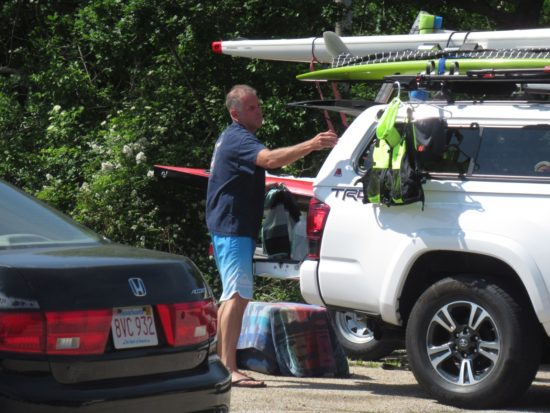
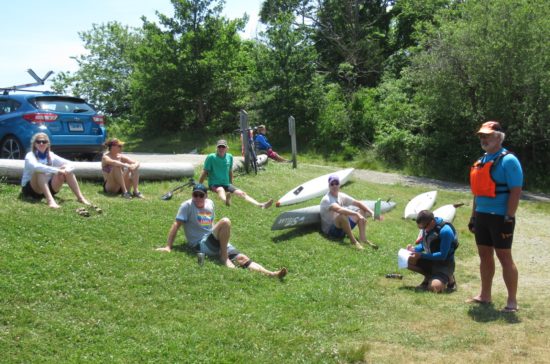
Given the dearth of racing opportunities, RTB lured in an impressive set of paddlers from well outside New England. Ed Joy and John Hair drove in from Central New York, Eric Costanzo and Rob Jehn narrowly escaped from New Jersey, and Rick Carter pulled a trailer of boats up from South Carolina. This group was supplemented by a scruffy crew of suspicious locals, warily eyeing the exotic headdresses and gaudy pantaloons of the interlopers. Doubtless, we were all thinking of the enigmatic prophecy that I had intoned a few minutes earlier while in a trance-like state: “Those bastards are going to take all our hardware.”
As the paddlers trickled into the parking lot (understandably, we all wanted to avoid the virus-laden surfaces of the port-a-johns), some semblance of normalcy was restored to our quarantined lives. Our unpracticed social-distanced greetings were occasionally stilted and embarrassing (apparently wrapping your head and torso in a space blanket, dousing yourself with bleach, and chest-bumping your buddies hasn’t yet caught on), but everyone was excited to reconnect after the unnaturally extended off-season. Dr. Costanzo, straight from the front-lines of intensive COVID care was positively giddy at the prospect of socializing in a wholesome outdoors setting. Perhaps less so about being chased around the parking lot by a blind, silver-shrouded idiot.
Once the congregants had all arrived, Wesley convoked the captain’s meeting and led us in a solemn prayer. Actually, he mainly just droned on about the race while I got in touch with my spiritual side – making binding contracts with various deities, saints, djinns, fiends, and saboteurs. Every one of them a charlatan, as it turns out. Just as well. I already had six or seven reverse mortgages out on my soul. The current RTB course has been tweaked to perfection over the past several years through a sadistic process of trial-and-terror. Starting from West Cove, we make our way upwind to Mackerel Cove, round a mooring buoy several hundred meters into that bay, and head out to channel buoy G7. From there we head less-than-more downwind past the House on the Rock to buoy G11, then back past West Cove for a second lap of the same course. As a final slap in the face, we then slog through a bonus leg directly back to G7, rounding that to finish back in our launch bay.
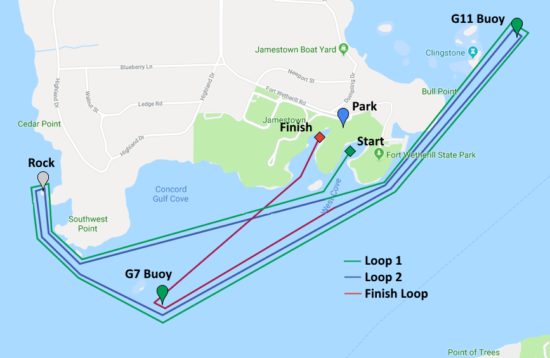
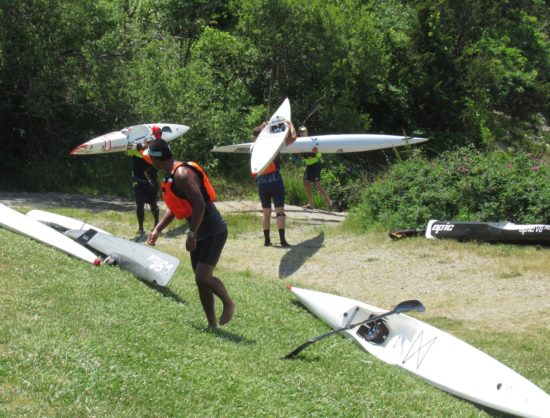
While awaiting the start, I weighed my chances against the competition. Ed would undoubtedly thrive in the breezy conditions, having cut his teeth paddling in Hawaii. He didn’t actually move to the Aloha State until middle age, by which time he already had realized considerable success in New England (as attested to by his 4 Blackburn titles). So I supposed it was more of sharpening than a cutting. Rob and I had traded head-to-head wins in the Blackburn and L2L last year, but an unusual reverse anonymous tip from Craig Impens on Facebook alerted me that somebody was putting up gaudy training stats. Under intense grilling, Rob cracked and revealed that he could have been somebody. John has been participating in the same virtual race series as I have, putting up comparable times but in a slower boat. Jim Hoffman was always a threat in rough water, although social distancing had eliminated one of his key assets – the spine-cracking bear hug that he greets his rivals with. Chris Quinn wasn’t actually present, but his last-minute appearance was as inevitable as his shirtlessness.
Anticipation grew to a frenzied peak as Wesley counted us down to the first start of the season. And then it waned as he was forced to scrub the launch at T-minus 15 seconds to accommodate Quinn and a couple of other stragglers. I took the opportunity to redistribute some combustible gases prior to the clock reset. Shortly thereafter we were streaking out of West Cove. I started to the left to avoid being squeezed against the rocky island at the entrance to the cove, which gave me an excellent view of the two-thirds of the field ahead of me at that turn. Smelling the podium from the get-go, Ed, Rob, and John seized immediate control of the race. Within the first quarter-mile, the radiant elites had already separated themselves from the squalid underclass (their term for us, I’m betting). Eric led that chase group, with Chris Q, Tim, Wesley, Jim, and me in active pursuit. By the time we had reached the entrance to Mackerel Cove, I had dropped the others and pulled within a couple of lengths of Eric and Chris. Based on the gap the leaders had on us in the first ten minutes, it seemed like we were already racing for 4th.
I made the right turn into Mackerel Cove a little more exciting than was strictly necessary by cutting inside of Eric and Chris. With quartering port waves pushing me towards the rocks and reflected slop compromising my ability to navigate a straight line, I meandered drunkenly in the confused waters, narrowly skirting several outcroppings. As we subsequently headed towards the turn buoy in calmer conditions, a surprise appearance by Tim’s bow alerted me that he hadn’t been quite as dropped as the previous paragraph indicated. The four of us made the turn within a couple of lengths of one another and headed out towards G7 on a beam run.
Within the first few minutes of the race, I had assumed a paddling posture best described as a “defensive crouch”. Back hunched. Head down. Shoulders forward. Hands never more than a foot from the torso. I recently watched Ivan Lawler’s excellent six-part YouTube series on paddling techniques and off-water exercises. Ivan conveyed an overwhelming amount of information. But if you remember just one thing from those two hours of instruction… well, that’s one more that I can now recall. Maybe something about dots lining up on your shirt? Oh, yeah! Also, don’t wear socks. So the take-home message was mostly sartorial advice. Despite some fogginess on the content, I’m positive that Ivan said nothing about the critical role of the defensive crouch. I’m assuming this is because he’s concentrating on flat-water paddling, where the danger level rarely exceeds “aggressive otter”. In big conditions, however, the crouch puts you that much closer to your safe space – the fetal position. If things get too hairy, you just armadillo up and wait for the coyote to tire itself out. In this metaphor, the coyote is the entire atmospheric-oceanic system, so be sure to bring plenty of snacks.
Although I was ready to spring out of action at the first sign of danger, I still managed to maintain a reasonable pace during this leg. I reached the G7 turn ahead of our gang of four. I was looking forward to the run to the final turn of the first lap, but knew that I’d have to work hard to stay ahead of the skilled downwind paddlers just a couple of lengths back. Sure enough, it wasn’t long before I watched Eric pull even (OK, maybe slightly ahead) on an inside line. Just a moment later, however, I watched him tumble into the sea – an uncharacteristic gaffe for such an accomplished rough-water paddler. Given that Eric hasn’t had much opportunity to train – what with literally putting his own life at risk to help hundreds of seriously ill COVID patients – maybe I’ll give him a pass on being a bit rusty. It’s a shame because I was lining up a pretty good joke at Medicine Boy’s expense.
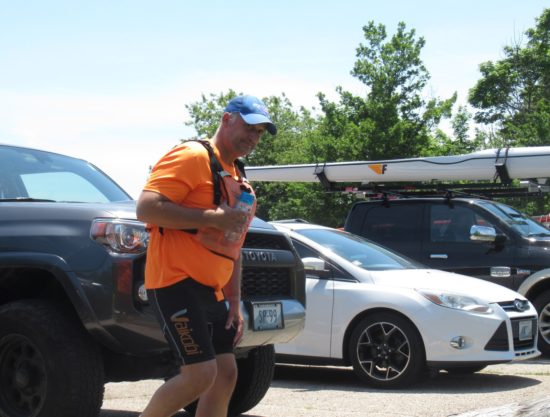
I quickly calculated the absolute minimum amount of concern I needed to demonstrate for Eric’s safety. He hadn’t immediately sunk out of view, was clearly conscious, and both Tim and Chris had slowed up right behind him. Right. So… two concerned looks over the shoulder, five missed strokes, and a slightly guilty expression – that oughta cover it! I was back on my way, no worse for Eric’s wear. Incidentally, he ultimately finished the race, so apparently his remount was a success.
The area adjacent to the House on the Rock is renowned for its wacky tidal currents, imposing standing waves, and boat-swallowing vortexes. I entered this area with some degree of trepidation and involuntary clenching but was surprised to find the conditions quite manageable. Pleasant, even. I was able to get a good read on the leaders starting back upwind, still holding together and now perhaps 90 seconds ahead. Finishing my own turn on G11, I estimated that my lead over Chris and Tim was now halfway between marginal and tenuous.
I struggled during the long trip back to Mackerel Cove. I didn’t feel so much “unstable” in the conditions as I did “uncoordinated”. Given the peerless grace I generally evince these days, it’s probably difficult for recent acquaintances to believe that I went through an awkward phase in my youth. I was gawky and bumbling, with a real knack for accidental pratfalls (that is, falls) and spontaneous injuries. For a brief span – not much more than a half-century tops – I was a master of self-imposed physical humiliation. Ever since whacking myself in the head with a strap buckle the morning of the race, I had figured those days of gangly ineptitude were long behind me. But here I was struggling to put together three recognizable strokes in a row. The worst part is that it wasn’t that rough – several other RTB and Double Beaver races had more challenging conditions.
Despite my bungling, I reached the entrance to Mackerel Cove ahead of Chris and Tim. Having learned my lesson during the first lap (that lesson being: “It’s possible, by sheer happenstance, that you will survive taking hare-brained risks”), I proceeded to again cut the corner amidst jacked-up waves and find myself dangerously close to the rocks. I made it through. Now that I’m 2-for-2, I can safely substitute “probable” for “possible” in my lesson plan. I made the buoy turn and headed back out to G7. Conditions seemed to have worsened since my last visit to this leg. Near the mouth of the cove, I swamped my boat and narrowly avoided inversion.

At this point, you’re doubtless wondering how Hall of Fame pitcher Satchel Paige might be relevant to my race. Thanks for asking. If Paige hadn’t been denied access to the Majors until 1948 (when he was 42), we wouldn’t have to spend half of each captain’s meeting arguing about whether the best league pitcher of the 1930s was Mel Harder, Red Ruffing, or Lon Warneke. Paige knew a thing or two about aging gracefully – pitching into his fifties – and blessed us with six keys to keeping young in his autobiography. The most famous of these is “Don’t look back. Something might be gaining on you.” This is particularly pertinent to surfski racing in sloppy conditions, where a glance over my shoulder inevitably results in competitors gaining on a now-swimming me. Another apt rule is “Avoid fried meats, which angry up the blood.” It was only after I got off the schnitzel that I started to see podium finishes. For this race, however, I concentrated on Satchel’s third key to longevity – “Keep the juices flowing by jangling around gently as you move.” I don’t know what went wrong. I was jangling all over the place, but watching the leaders pull further ahead, I couldn’t shake the feeling of being over the hill. A close review of my GoPro video afterwards revealed the problem. I don’t know if you’d categorize it as floundering or flailing, but my crazy marionette moves sure as heck weren’t jangling.
The half-mile (with liberal rounding) trip to G7 took a couple of hours. My reward for this toil was a whack-a-mole downwind leg in which I managed to miss 95% of the available rides. Ahead, the leaders had achieved moteness. At the G11 turn, Chris was perhaps a dozen lengths back, with Tim about the same behind him. I felt fairly confident about being able to hold them off, but I wasn’t looking forward to it.
On the upwind leg of the first couple of laps, there were some clandestine waves travelling against the prevailing runners. They were lightly encrypted, but the system administrator neglected to change the default password so it was easy enough to break the code and find some modest reprieves during the headwind slog. Unfortunately, there must have been a North Korean hacker scare prior to the final leg back to G7, because any countervailing waves were now protected with some kind of flux-inverted quantum encryption. On the off-chance that the admin had left some kind of back door password, I tried every expletive permutation I could think of. No dice. Fatigued and dispirited by the relentless grind through lumpy seas, my ragged stroke degraded further. At random intervals I would tentatively pluck the water with a paddle blade, like a kitten lazily batting at a ball of yarn (but with considerably less power). My Garmin was technically still indicating a positive velocity, but “zero” also fell within the GPS margin of error.
Despite my worst efforts, I managed to reach G7. My attempt to round the buoy was flattened out considerably as I misjudged the approach and was nearly side-swiped into the can by a broaching wave. I briefly considered vaulting out of the cockpit, clambering up onto the green platform, and there napping away the rest of the afternoon. Catching a glimpse of Chris and Tim just a few lengths back, however, I abandoned my dream and recommitted myself to limping home ahead of those heel nippers. It’s a bell buoy anyway. I’d have never gotten any decent shut-eye.
The waves on the final leg lined up pretty cleanly with our destination, so I actually experienced a few instances of joy in my final moments. I had held onto 4th place. Ed convincingly took the crown, finishing two-and-a-half minutes ahead of Rob, with John less than thirty seconds further back. I was [redacted] minutes behind John. It was a tough race. I clocked at least six capsizes (including a rare triple by one paddler), but nobody got in any real trouble. There were three DNFs, although all of them seemed to be of the “screw this noise” variety, rather than an inability to complete the course. All in all, a bracing day on the Bull.
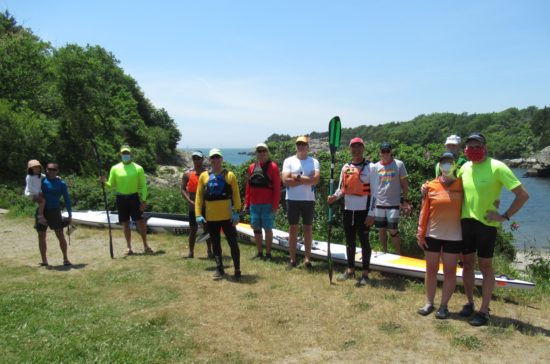
Thanks to Wesley and Tim for getting us out of our houses and back onto (or into) the water. Next up is Eric McNett’s Casco Bay Challenge on July 4th. There’s no pre-registration this year – just find a shady looking shirtless guy on Willard Beach, slip him a wad of bills, and he’ll set you up. A week later (July 11th), why not return to Rhode Island for Wesley’s Sakonnet River Race? Register at PaddleGuru. Note that the race will start at Island Park Beach rather than at McCorrie Point.
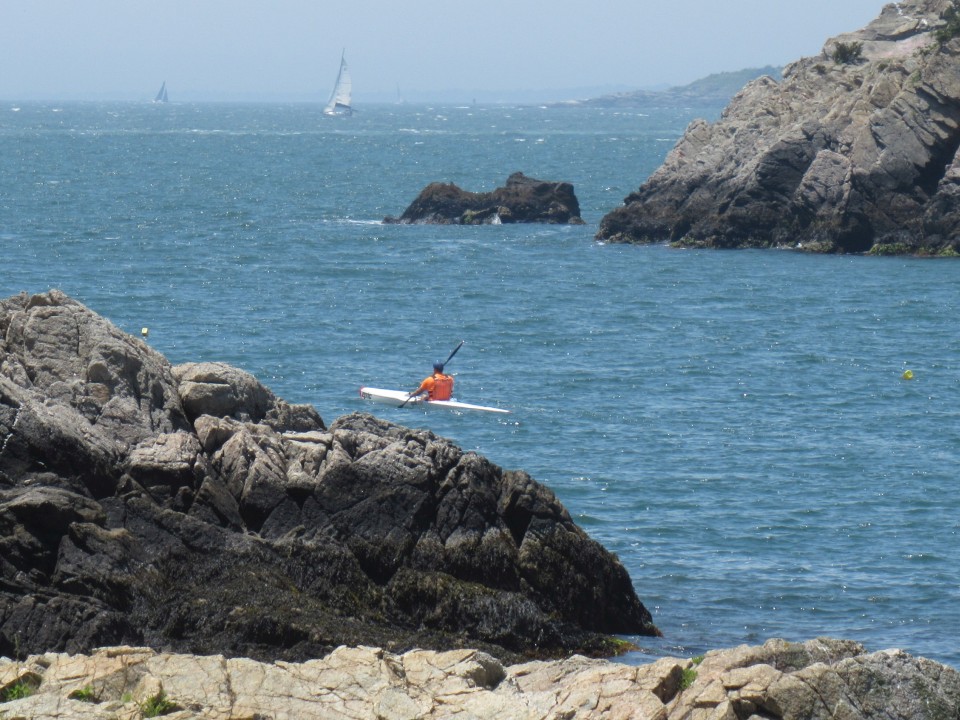
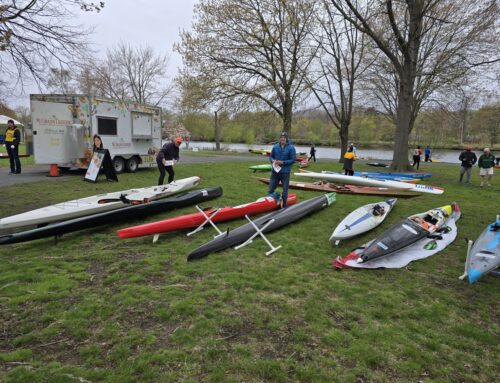
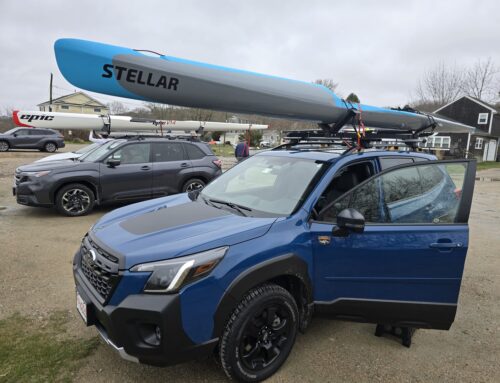
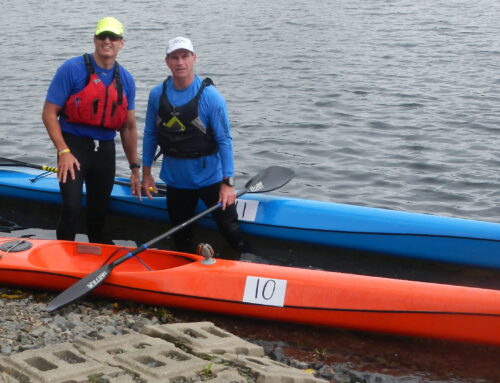
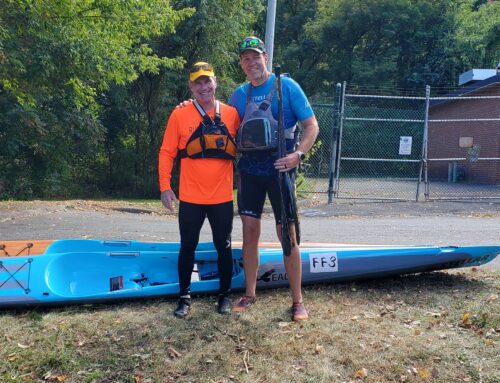
Leave A Comment
You must be logged in to post a comment.